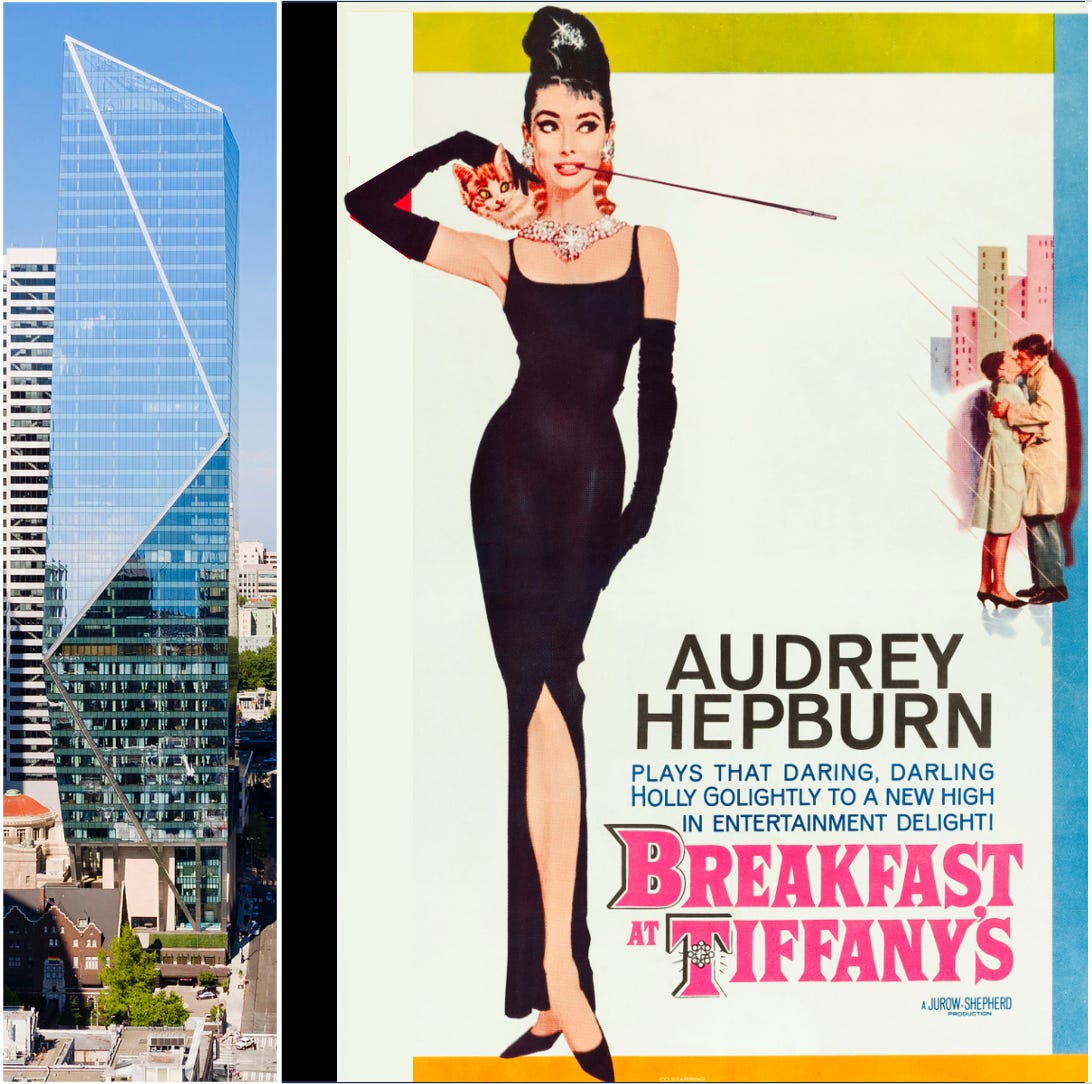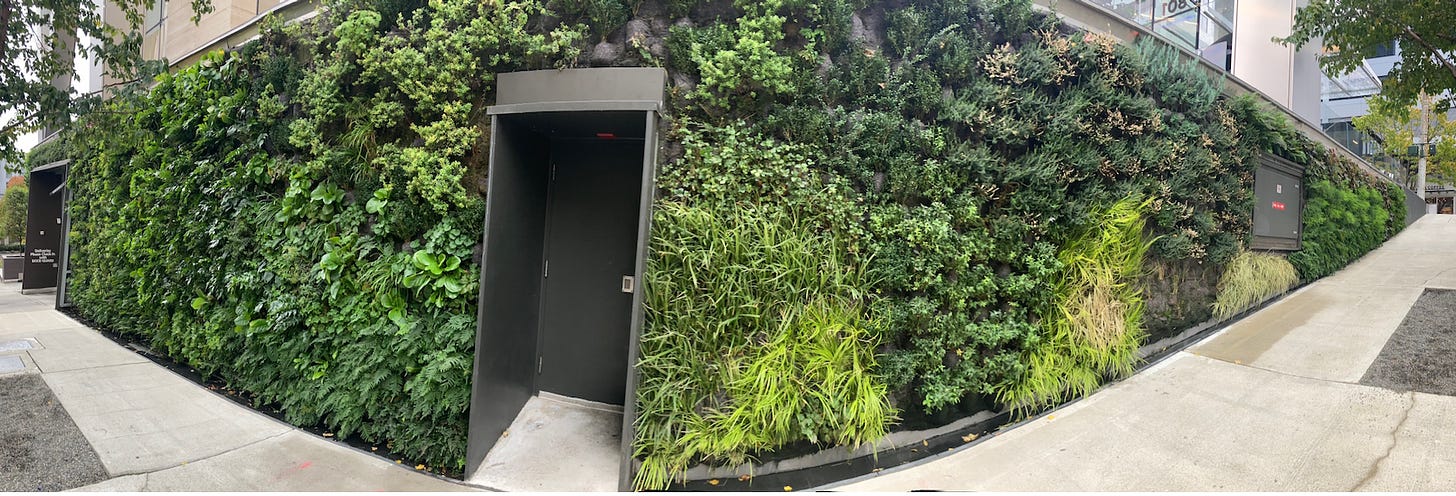In 2017, a new skyscraper appeared in Seattle. Like many of its contemporaries, the F5 building (aka The Mark) wears a skin of glass, a type of cladding that seems banal to me, unlike granite or marble or limestone or any other type of rock, each of which is glorious and lively. (Perhaps, to make up for their choice of glass, the architects gave the tower a shape apparently inspired by Aubrey Hepburn’s profile in Breakfast at Tiffany’s. I’ll let you decide if they succeeded in A) copying Ms. Hepburn and B) giving the building character.)
But for those who seek out a far more interesting and appealing aspect of the building, I suggest looking down, or at least at street level, particularly at the south wall running on Columbia Street between 5th Avenue and 4th Avenue. There you will find an unexpected and unique wall of green consisting of hundreds of plants. All are alive and well and growing in a specially designed environment that uses no soil. (Other totally cool, building features are the travertine (a type of limestone that forms in hot springs) panels around the entrance; they come from the same quarry area in Tivoli, Italy, that supplied travertine for the Colosseum. Note the small honeycombs covering many panels. The holes were once gas bubbles, which were coated so quickly in calcite that they petrified.)
The idea of the wall originated with real estate developers Kevin Daniels and Carl Shumaker and his daughter Kimberly Shumaker, who was a principal designer, along with Mike Weinmaster of Green Over Grey: Living Walls and Design. Mike told me in an email: “The plants grow in layers of moss-mimicking fabric where their roots are free to grow everywhere within the living wall support. Therefore, there are no space limitations at the root level and the plants are able to grow to their full potential...No soil is used, so the system is essentially hydroponic. This makes it very light, thin (can be as thin as 2 inches), and clean.”
The designers’ goal was to introduce vegetation into the urban core. “Seattle is surrounded by two mountain ranges. How many people wish they could find such nature in the urban core?,” says Kimberly. “Our goal was to bring nature to you.” She was initially inspired by the mountains and creating a panoramic feel to the wall, with plants chosen to reflect different spaces such as mountains, lakes, and valleys. The wall contained more than 3,100 plants totaling more than 60 varieties.
I first remember seeing the wall sometime after the building opened in 2017. I worried that it would be vandalized but apparently it suffered little at the hands of miscreants. Instead, a lapse of maintenance lead to many plants dying because of lack of water. Fortunately, the wall has recently been replanted and the irrigation system upgraded so it is back to its original beauty. It also has a new design (by Mike and his team), which incorporates plants that require less maintenance and yet are still diverse, with 70 species. They include blueberries and strawberries (both edible), as well as many flowering plants, such as yarrow, bellflower, bleading heart, and catmint, that provide food for pollinators.

When I spoke with Kimberly, she made a point very dear to my heart, that nature is all around us. “It’s important to stop and take a moment to pause and see what’s right in front of you.” Here it is: nature in the city, so obvious and so lovely. This verdant wall of life is a place I will want to return to again and again, to see who visits, human and more-than-human, and perhaps to eat a blueberry or strawberry.
Thanks to Kevin, Kimberly, and Mike for answering my questions about the wall.
I know I said last week that I wouldn’t go political but after the recent rally in New York with its vile misogyny, racism, and bullying, I can’t not comment. I simply ask what kind of country are we? Do you want to live in a country presided over by a person who condoned and clearly agreed with the horrible comments in New York or a person who respects and shows compassion for other people and who believes in democracy, tolerance, and civility?
Upcoming Events
November 7 - I will be talking at 5:30 PM about Spirit Whales and Sloth Tales at Kingfisher Bookstore in Coupeville on Whidbey Island.
November 9 - I will be speaking at 10:30am about Spirit Whales and Sloth Tales at the Old Redmond Schoolhouse for the Redmond Historical Society.






Just a few blocks away at 5th and Madison, the Madison Centre has living wall, but inside. It's in the first floor atrium (one floor up from street level on 5th) and is open to the public. At least it was when I worked there a couple years ago, which is why I know about it.
https://schnitzerwest.com/projects/madison-centre/
David's mention of preferring stone buildings over glass is a subtle nod to his wonderful book, "Stories in Stone: Travels through Urban Geology."
What were "Noah's ravens"? Where, and how, did Michaelangelo procure his huge slabs of marble? What made a Spanish fort in Florida immune to English cannonballs?
Each of these questions has its own chapter in this engrossing book.